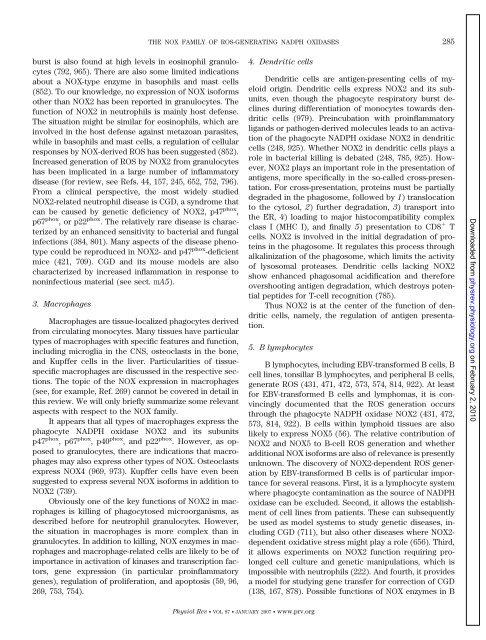Karen Bedard and Karl-Heinz Krause
Karen Bedard and Karl-Heinz Krause
Karen Bedard and Karl-Heinz Krause
Create successful ePaper yourself
Turn your PDF publications into a flip-book with our unique Google optimized e-Paper software.
urst is also found at high levels in eosinophil granulocytes<br />
(792, 965). There are also some limited indications<br />
about a NOX-type enzyme in basophils <strong>and</strong> mast cells<br />
(852). To our knowledge, no expression of NOX isoforms<br />
other than NOX2 has been reported in granulocytes. The<br />
function of NOX2 in neutrophils is mainly host defense.<br />
The situation might be similar for eosinophils, which are<br />
involved in the host defense against metazoan parasites,<br />
while in basophils <strong>and</strong> mast cells, a regulation of cellular<br />
responses by NOX-derived ROS has been suggested (852).<br />
Increased generation of ROS by NOX2 from granulocytes<br />
has been implicated in a large number of inflammatory<br />
disease (for review, see Refs. 44, 157, 245, 652, 752, 796).<br />
From a clinical perspective, the most widely studied<br />
NOX2-related neutrophil disease is CGD, a syndrome that<br />
can be caused by genetic deficiency of NOX2, p47 phox ,<br />
p67 phox ,orp22 phox . The relatively rare disease is characterized<br />
by an enhanced sensitivity to bacterial <strong>and</strong> fungal<br />
infections (384, 801). Many aspects of the disease phenotype<br />
could be reproduced in NOX2- <strong>and</strong> p47 phox -deficient<br />
mice (421, 709). CGD <strong>and</strong> its mouse models are also<br />
characterized by increased inflammation in response to<br />
noninfectious material (see sect. IIIA5).<br />
3. Macrophages<br />
Macrophages are tissue-localized phagocytes derived<br />
from circulating monocytes. Many tissues have particular<br />
types of macrophages with specific features <strong>and</strong> function,<br />
including microglia in the CNS, osteoclasts in the bone,<br />
<strong>and</strong> Kupffer cells in the liver. Particularities of tissuespecific<br />
macrophages are discussed in the respective sections.<br />
The topic of the NOX expression in macrophages<br />
(see, for example, Ref. 269) cannot be covered in detail in<br />
this review. We will only briefly summarize some relevant<br />
aspects with respect to the NOX family.<br />
It appears that all types of macrophages express the<br />
phagocyte NADPH oxidase NOX2 <strong>and</strong> its subunits<br />
p47 phox , p67 phox , p40 phox , <strong>and</strong> p22 phox . However, as opposed<br />
to granulocytes, there are indications that macrophages<br />
may also express other types of NOX. Osteoclasts<br />
express NOX4 (969, 973). Kupffer cells have even been<br />
suggested to express several NOX isoforms in addition to<br />
NOX2 (739).<br />
Obviously one of the key functions of NOX2 in macrophages<br />
is killing of phagocytosed microorganisms, as<br />
described before for neutrophil granulocytes. However,<br />
the situation in macrophages is more complex than in<br />
granulocytes. In addition to killing, NOX enzymes in macrophages<br />
<strong>and</strong> macrophage-related cells are likely to be of<br />
importance in activation of kinases <strong>and</strong> transcription factors,<br />
gene expression (in particular proinflammatory<br />
genes), regulation of proliferation, <strong>and</strong> apoptosis (59, 96,<br />
269, 753, 754).<br />
THE NOX FAMILY OF ROS-GENERATING NADPH OXIDASES 285<br />
4. Dendritic cells<br />
Dendritic cells are antigen-presenting cells of myeloid<br />
origin. Dendritic cells express NOX2 <strong>and</strong> its subunits,<br />
even though the phagocyte respiratory burst declines<br />
during differentiation of monocytes towards dendritic<br />
cells (979). Preincubation with proinflammatory<br />
lig<strong>and</strong>s or pathogen-derived molecules leads to an activation<br />
of the phagocyte NADPH oxidase NOX2 in dendritic<br />
cells (248, 925). Whether NOX2 in dendritic cells plays a<br />
role in bacterial killing is debated (248, 785, 925). However,<br />
NOX2 plays an important role in the presentation of<br />
antigens, more specifically in the so-called cross-presentation.<br />
For cross-presentation, proteins must be partially<br />
degraded in the phagosome, followed by 1) translocation<br />
to the cytosol, 2) further degradation, 3) transport into<br />
the ER, 4) loading to major histocompatibility complex<br />
class I (MHC I), <strong>and</strong> finally 5) presentation to CD8 � T<br />
cells. NOX2 is involved in the initial degradation of proteins<br />
in the phagosome. It regulates this process through<br />
alkalinization of the phagosome, which limits the activity<br />
of lysosomal proteases. Dendritic cells lacking NOX2<br />
show enhanced phagosomal acidification <strong>and</strong> therefore<br />
overshooting antigen degradation, which destroys potential<br />
peptides for T-cell recognition (785).<br />
Thus NOX2 is at the center of the function of dendritic<br />
cells, namely, the regulation of antigen presentation.<br />
5. B lymphocytes<br />
Physiol Rev VOL 87 JANUARY 2007 www.prv.org<br />
B lymphocytes, including EBV-transformed B cells, B<br />
cell lines, tonsillar B lymphocytes, <strong>and</strong> peripheral B cells,<br />
generate ROS (431, 471, 472, 573, 574, 814, 922). At least<br />
for EBV-transformed B cells <strong>and</strong> lymphomas, it is convincingly<br />
documented that the ROS generation occurs<br />
through the phagocyte NADPH oxidase NOX2 (431, 472,<br />
573, 814, 922). B cells within lymphoid tissues are also<br />
likely to express NOX5 (56). The relative contribution of<br />
NOX2 <strong>and</strong> NOX5 to B-cell ROS generation <strong>and</strong> whether<br />
additional NOX isoforms are also of relevance is presently<br />
unknown. The discovery of NOX2-dependent ROS generation<br />
by EBV-transformed B cells is of particular importance<br />
for several reasons. First, it is a lymphocyte system<br />
where phagocyte contamination as the source of NADPH<br />
oxidase can be excluded. Second, it allows the establishment<br />
of cell lines from patients. These can subsequently<br />
be used as model systems to study genetic diseases, including<br />
CGD (711), but also other diseases where NOX2dependent<br />
oxidative stress might play a role (656). Third,<br />
it allows experiments on NOX2 function requiring prolonged<br />
cell culture <strong>and</strong> genetic manipulations, which is<br />
impossible with neutrophils (222). And fourth, it provides<br />
a model for studying gene transfer for correction of CGD<br />
(138, 167, 878). Possible functions of NOX enzymes in B<br />
Downloaded from<br />
physrev.physiology.org on February 2, 2010













